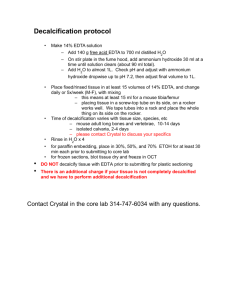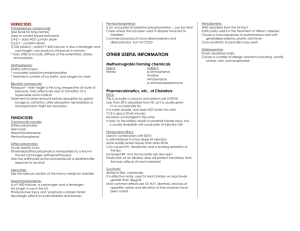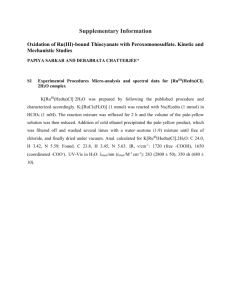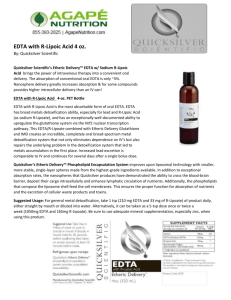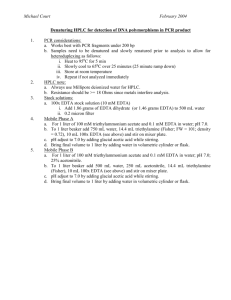SPECIMEN COLLECTION/PROCESSING/SHIPMENT PROTOCOL
advertisement
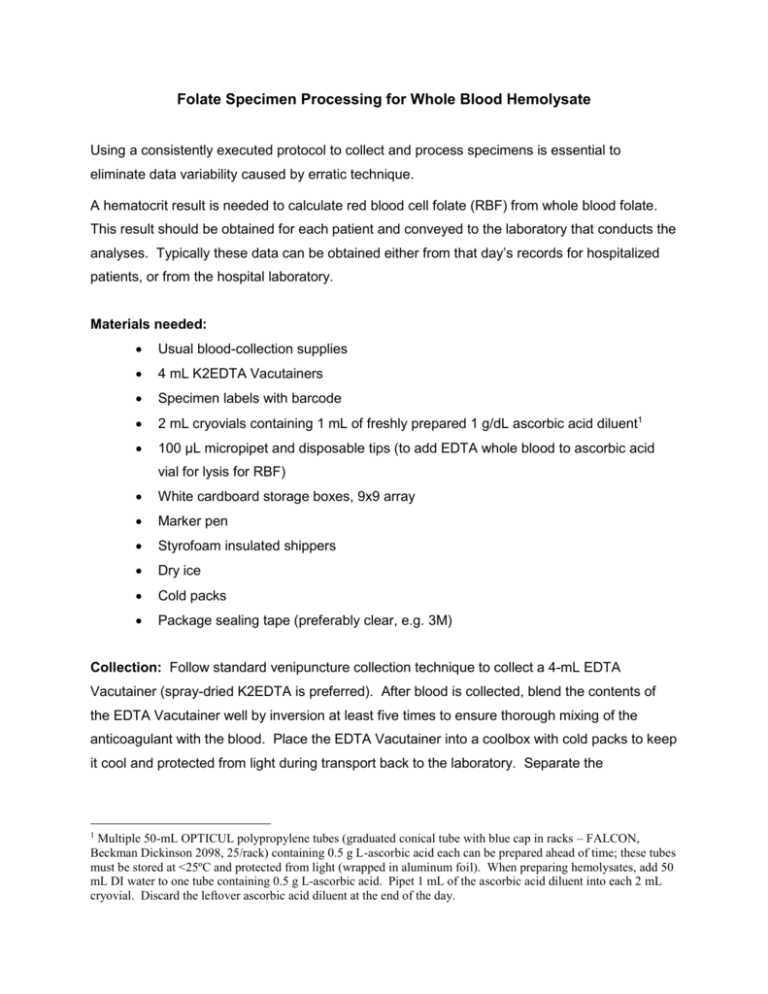
Folate Specimen Processing for Whole Blood Hemolysate Using a consistently executed protocol to collect and process specimens is essential to eliminate data variability caused by erratic technique. A hematocrit result is needed to calculate red blood cell folate (RBF) from whole blood folate. This result should be obtained for each patient and conveyed to the laboratory that conducts the analyses. Typically these data can be obtained either from that day’s records for hospitalized patients, or from the hospital laboratory. Materials needed: Usual blood-collection supplies 4 mL K2EDTA Vacutainers Specimen labels with barcode 2 mL cryovials containing 1 mL of freshly prepared 1 g/dL ascorbic acid diluent1 100 µL micropipet and disposable tips (to add EDTA whole blood to ascorbic acid vial for lysis for RBF) White cardboard storage boxes, 9x9 array Marker pen Styrofoam insulated shippers Dry ice Cold packs Package sealing tape (preferably clear, e.g. 3M) Collection: Follow standard venipuncture collection technique to collect a 4-mL EDTA Vacutainer (spray-dried K2EDTA is preferred). After blood is collected, blend the contents of the EDTA Vacutainer well by inversion at least five times to ensure thorough mixing of the anticoagulant with the blood. Place the EDTA Vacutainer into a coolbox with cold packs to keep it cool and protected from light during transport back to the laboratory. Separate the Multiple 50-mL OPTICUL polypropylene tubes (graduated conical tube with blue cap in racks – FALCON, Beckman Dickinson 2098, 25/rack) containing 0.5 g L-ascorbic acid each can be prepared ahead of time; these tubes must be stored at <25ºC and protected from light (wrapped in aluminum foil). When preparing hemolysates, add 50 mL DI water to one tube containing 0.5 g L-ascorbic acid. Pipet 1 mL of the ascorbic acid diluent into each 2 mL cryovial. Discard the leftover ascorbic acid diluent at the end of the day. 1 Vacutainers and the cold packs with paper to avoid unintentional hemolysis of red cells. Discard the blood-collection supplies properly in accordance with hospital regulations. Processing: Return to the laboratory promptly. Ideally, the whole blood should be lysed the same day as it was collected. However, if that is not possible, the EDTA Vacutainer tube may be kept in the refrigerator protected from light for a maximum of 4 days before lysis. When ready to lyse the whole blood, prepare the ascorbic acid diluent as described in the footnote. Allow the EDTA Vacutainer to reach room temperature and re-mix its contents by inversion at least 8–10 times. Remove the stopper of the EDTA Vacutainer and pipet 100 µL of well-mixed blood into the vial containing the thawed ascorbic acid (rinse the pipette tip 3–4 times with the hemolysate); mix well (avoid foaming). Determine the hematocrit by using a portion of the remaining EDTA whole blood. If EDTA plasma is needed for analysis, re-stopper the EDTA Vacutainer carefully and centrifuge it for 10 minutes at 2500–2800 RPM to separate the plasma from the cells. If EDTA plasma is not needed, discard the Vacutainer properly in accordance with hospital regulations. Storage: Place all RBF samples (lysed whole blood) in white 9x9 array cardboard storage boxes labeled appropriately for the study, and freeze all samples at -70C. When filling the box, mark the top left corner with a marker pen to indicate starting point. Continue to fill each row, left to right, until box is completely filled. As patient samples are collected and processed, create a log sheet for each box listing the patient ID, date collected, location of the vials in the box, and any pertinent information that may affect assay results, such as short draw, fasting status if known, hemolysis, or lipemia, and the patient hematocrit result for correct calculation of the RBF. Transport: Wrap the pre-labeled, white storage box with absorbent paper, place it in a ziplock bag, and seal the bag. Place the ziplock bag in the bottom of the shipping box. The specimens must remain in a vertical position; if necessary, use bubble wrap to keep them upright. Fill the styrofoam-lined shipping box with dry ice. Allow one pound of dry ice for every 2 hours in transport. Close the styrofoam lid. Place a copy of the study log sheet describing these samples between this lid and the outer cardboard lid. Seal the outer carton lid. Telephone the laboratory at your destination the day the shipment is mailed.



